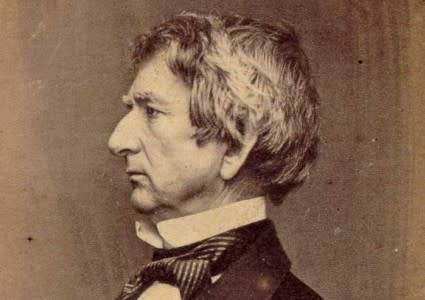Remembering William Seward’s Alaska ‘folly’
Today marks the anniversary of one of the most controversial land deals in American history: the Alaska Purchase or Seward's Folly. On October 18, 1867, the United States took possession of Alaska from Russia under the terms of a formal land transfer, in a ceremony in the town of Sitka.
In today’s popular culture, William Seward is best known for his association with Abraham Lincoln. But his name is also forever linked to a decision back that brought Alaska into the fold as a United States territory, at a bargain price.
The cost for Alaska in 1867 was $7.2 million, which is about $119 million in current dollars.
Link: Read the treaty
Secretary of State Seward negotiated the deal in an extended bargaining session with Russian minister to the United States Eduard de Stoeckl on March 30, 1867. The Senate passed the treaty a few days later, but the House held up funding the purchase for more than a year, as the public debate raged over the purchase price and soundness of Seward’s decision.
The Alaska Purchase gave the United States a land mass of 586,412 square miles, an area about twice the size of Texas. But it came at a time when the United States had just ended the Civil War, and it had an abundance of underpopulated land.
Prior to World War II, Alaska suffered from a bit of an inferiority complex and its own internal politics. In the wake of "Seward’s Folly," Alaska avoided national attention until its Gold Rush began in the 1890s.
It became a territory in 1912 and started making noise about becoming a state four years later. As its strategic importance became obvious during World War II, in 1946 Alaska held a referendum asking Congress to consider it for statehood.
The Democrats during the 1950s favored Alaska as the 49th state, while the Republicans wanted Hawaii admitted by itself. The reason was that each new state gets two U.S. senators and at least one new House member, and the admission of a new state can swing votes in Congress.
Alaska became the 49th state in January 1959 after a compromise was reached in Congress.
In recent years, there has been some revisionist history about Seward’s decision. In 2009, University of Iowa economist David Barker argued, using a different set of statistics, that the federal government has lost money on the Alaska deal since 1867—because of the amount of federal subsidies spent on Alaska. “The fact that the federal government has not profited from Alaska supports the contention of the new Western history that the West has generally been subsidized by the federal government,” he said.
That theory was contested on a New York Times blog a year later by two professors in Alaska, who said Barker’s calculations didn’t take into account broader measures.


